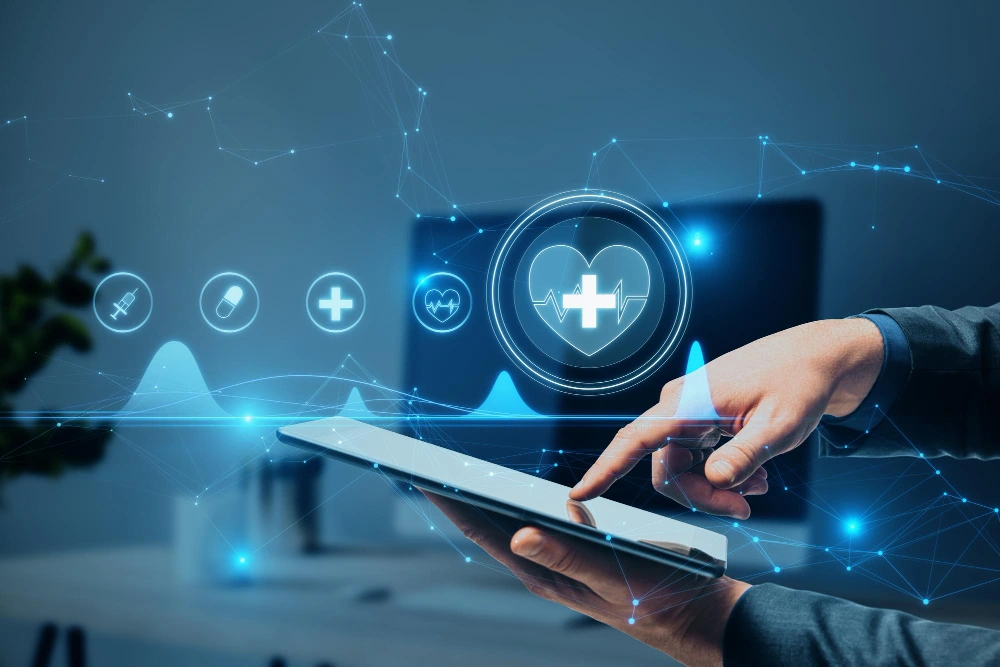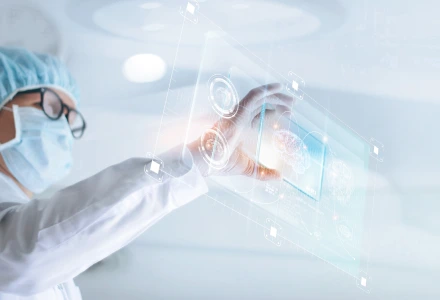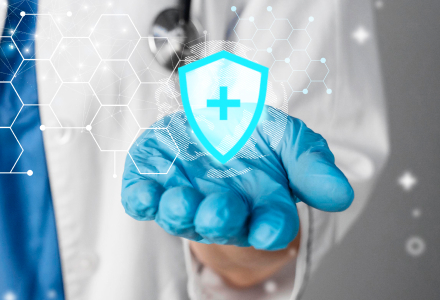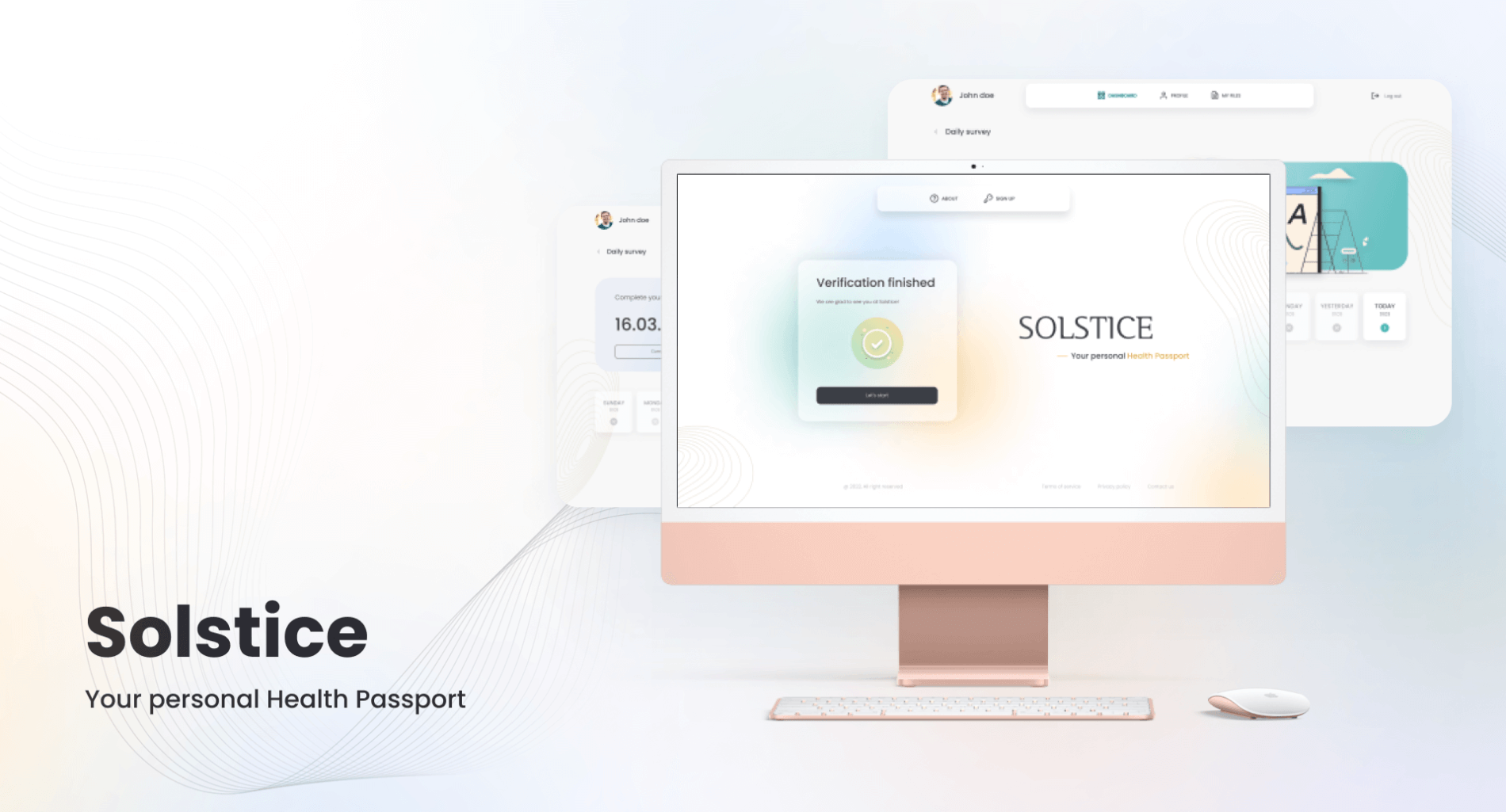We all know that healthcare is one of the fields that undergo challenges thanks to COVID-19 and digitalization. Since technologies are everywhere now and people prefer to use software over calls and physical visits to hospitals, both companies and healthcare organizations understand the need for medical software development.
 $39.38 billion
$39.38 billion
The global electronic health records market is projected to hit $39.38 billion by 2032.
 46%
46%
In 2022, North America accounted for 46% of the global EHR market share.
 25%
25%
In 2022, the EHR segment totalled more than 25% of the global eHealth market.
The technologies used in medical apps greatly simplify the consultation process, allowing doctors to better manage healthcare information and move all patient-physician interactions to an automated and efficient level. Patients also love the convenience that software brings, especially during times of COVID restrictions and increased use of mobile apps.
EHR and EMR software are the two most popular types of healthcare software that custom medical software development businesses create to reduce the paperwork and give access to patients’ data in a few clicks. Since these apps greatly improve the productivity of doctors, they have been shown to increase the revenue of a healthcare establishment and attract more users.
We curated this guide to help you develop EHR software, its definition, key features, development process, and cost.
What is an EMR/EHR System & What’s the Difference?
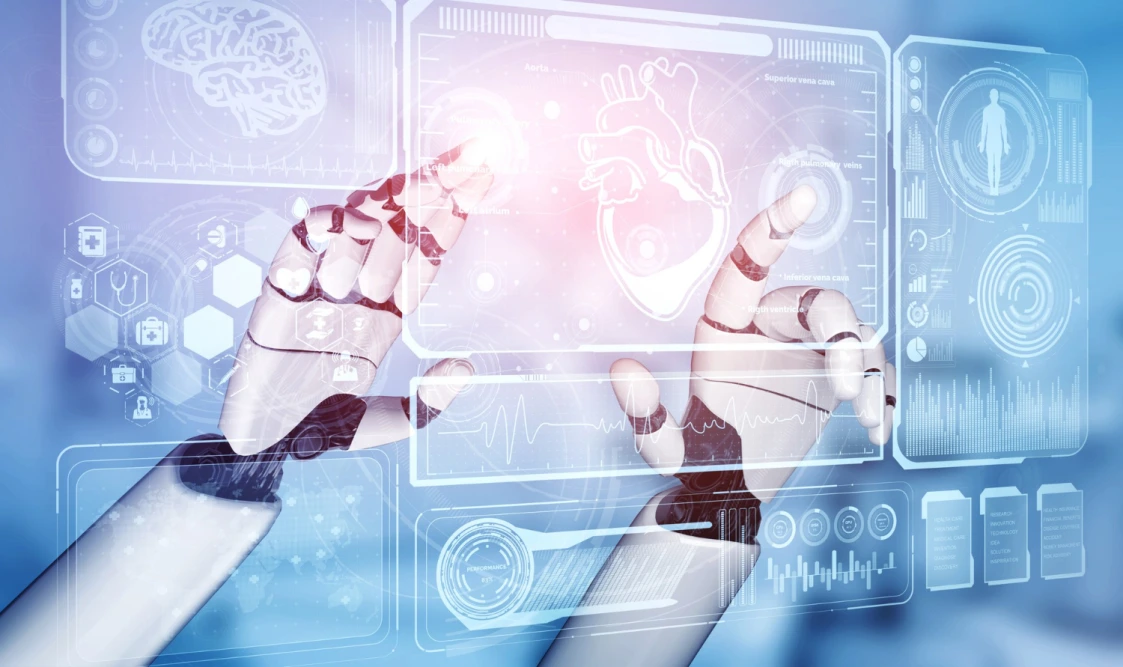
Electronic Medical Record (EMR)
EMR is short for Electronic Medical Record software which represents a digital version of the paper charts in the doctor’s office. An EMR is designed to contain all patients’ medical and treatment histories in one place.
EMR is preferred over paper data records since it allows companies to easily track data, identify patients that need preventive screenings or checkups, check how patients feel based on certain criteria, and always improve the care quality.
However, the data in EMRs cannot be easily transferred out of practice. To be more specific, the patient healthcare information may even have to be printed out and delivered by mail to doctors and other staff of the team. Considering this point, EMRs are similar to paper records.
Electronic Health Records (EHR)
EHR is short for Electronic Health Records and can also do all the mentioned things that EMR does. However, EHR software focuses on the total health of the patient, meaning it goes much beyond standard healthcare data collected in the provider’s organization and is inclusive of a broader view of a patient’s care.
That is why EHRs are used more commonly and are preferred over traditional paper records that collect and compile information. EHRs are developed to share information with other doctors and clinics since this can help laboratories and specialists provide more detailed analysis and significantly boost the care quality.
Benefits of Using an EMR and EHR Systems For Healthсare Organizations
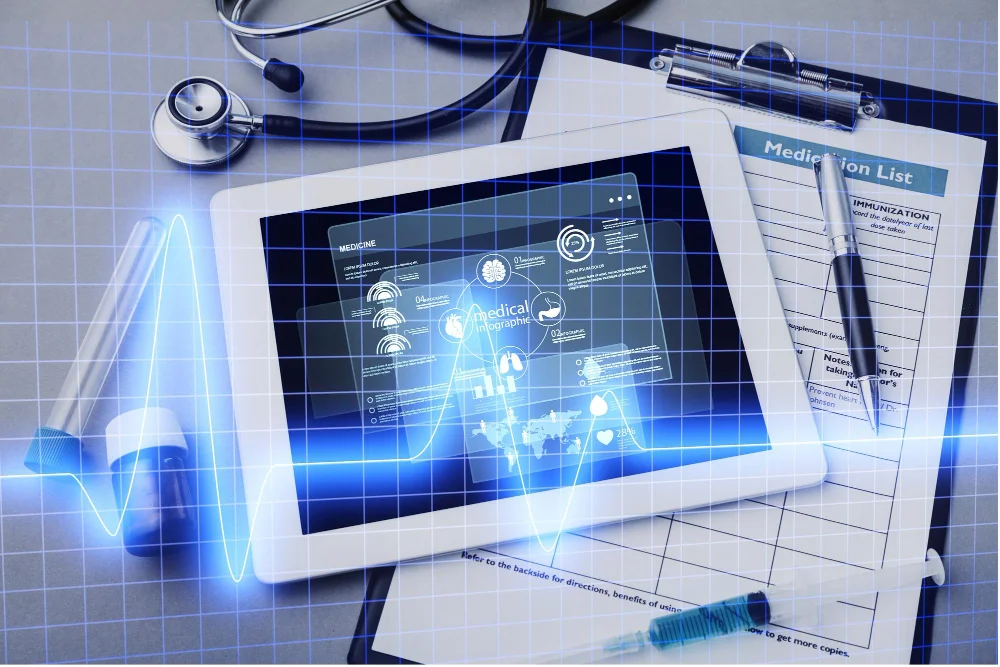
Convenience and Efficiency
When a healthcare or administrative team deals with physical papers and records, it usually means that it is a highly time-consuming working time. Not only does it take time that the team can spend on more valuable things, but it also can cause human errors that usually result in costly outcomes.
Taking away a team’s productivity isn’t a good thing to do in 2023. That is why EHR software development is a great solution. Quickly and easily finding the data you need at every given time offers ultimate convenience and increased efficiency of patient care. This is proven by the fact that more than 95% of US hospitals used a certified EHR platform in 2020.
Cost Reduction
All the papers you have that create a physical records system take space. To give this space, you also buy file cabinets, which not only cost money but take up your business space.
Therefore, EMR software development allows you to reduce the costs needed for paper storage while also freeing space for your business needs now or in the future. With these apps, you can easily store all papers and files on a single hard drive and be backed up by the Cloud.
Easily Organized and Referenced
As may be expected, organizing is essential for the healthcare industry now. That is why the development of EHR should always be easily organized and referenced.
Digital records are much easier to read and more legible. In addition, since the electronic health record stores all data in a standardized format, it makes it easy to skim through directly for the more relevant data based on your needs every time.
Easy Patient Access
Patient care should be on a brand new level in 2023. Now people want doctors to quickly get through their previous health data before an appointment. Doctors also want to make it easier for them to explore health records.
That is why EMR/EGR software development allows physicians to check a prescription that patients are on or share their medical history with a specialist. Patients now also can access their records.
An electronic health record system usually offers patients an online patient portal that they can use to access their medical history and data regardless of their time and location.
Higher Security
Modern people care about their data safety. Since the number of cyberattacks grows every day, it is now vital more than ever to properly secure patient data to avoid costly mistakes and gain trust. Since paper records are easy to lose, accidentally destroy, and steal, online EHR systems bring higher safety since they are stored in databases with private access.
Ready-Made vs. Custom EHR/EMR Solutions
Custom EHR/EMR Solutions
Most modern healthcare organizations choose to develop custom EHR/EMR solutions thanks to the following reasons:
- Custom features and functionality based on business needs.
- Custom software engineers pay close attention to customers’ business processes and needs, allowing users to adjust quickly to the product.
- Custom software ideally fits users’ security, software and hardware needs.
- No additional licensing fees are required.
- The software development provider offers constant support to its products, and all the problems are solved quickly.
Ready-Made EHR/EMR Systems
However, there is another appealing option, known as ready-made EHR/EMR software. Reasons why businesses choose this option are:
- Being industry-specific, these apps are likely to fit most business needs.
- A cost-effective solution since development costs are distributed throughout a large number of end-users.
- Ready-made software has many features that you can need later or start using later on as business evolves.
- Users can feel safe as vendors also provide support and maintenance services.
Explore our healthcare expertise and find out how Interexy can help you!
Book a call with our expertsMust-Have Features of an EHR/EMR System
-
Patient Portal or Profile
A patient portal in EMR software development works as a stand-alone app or as an extension to the system. To create a patient portal account, users should get corresponding documents such as activation codes or instructions that will help them activate and use the portal from the chosen healthcare provider.
-
Communication Features
Patients can use a patient portal or profile to efficiently get the needed information from their healthcare providers and vice versa. Communicating with the health care team can give a patient an easy way to provide appointment follow-ups, ask all health-related questions and easily get answers from psychics.
-
E-prescriptions
Allowing doctors to provide electronic prescribing is another must-have feature. Most modern patients using software for booking apps or consulting doctors also expect the provider to give e-prescriptions. That is because hand-written prescriptions are quite outdated. It not only makes it easier for patients to request prescription refills but also allows doctors to review all prescriptions and when users need to re-prescription as well.
-
Charting & Documentation Management
One of the main reasons for most healthcare organizations to use EHR/EMR systems is to manage the abundance of medical documentation. That is why you should definitely add a medical charting feature that will allow doctors to view detailed systematic information about doctors’ interactions with particular patients, conditions, treatment plans, results, and so on.
-
Lab Integration
Information from a laboratory can be used as an essential part of EHR and EMR software. Lab integration represents an electronic health records system used by systems to allow easy tracking and receiving of patients’ test results almost with no hassle. This feature has been shown to greatly help medical laboratories avoid the most common issues like human errors, time consumption, and inventory availability.
-
Role-Based Access Control
Since EMR and EHR systems contain sensitive patient data, they should be protected. Therefore, this feature is essential, and it will allow all hospital administrators, specialists, and physicians to access only needed information based on their access level.
-
Billing
EMR software implementation with billing features allows medical staff to keep expenditure records, generate and submit claims for reimbursement, and simplify working with self-pay patients. Advanced examples of EHR systems provide a convenient and fast billing system, facilitating the work of the finance department. They can track historical revenue, department-specific costs and billing and identify potential areas for improvement.
-
Customizable Forms and Templates
EHR software grants a hassle-free and efficient way to handle documentation and reduce paperwork by leveraging electronic forms. They can be used for patient registration, insurance and billing, consent, and allergies or customized to meet your clinic’s needs. The software also allows medical professionals to create templates that can be reused in the future or modified if necessary.
-
Appointment Management
The appointment management feature allows patients to schedule and cancel their appointments online with the help of the patient portal and synchronized calendars. Patients and doctors can receive reminders about upcoming visits or reschedule alerts. EHR streamlines appointment management for receptionists, as the system contains all the information regarding schedules, available physicians, dates, and times and presents them visually.
-
Reporting and Analytics
Embedded reporting features allow medical facilities to simplify and accelerate report creation. The tools can retrieve data from patient medical records, lab results, appointment logs, etc. and generate reports. This streamlines analytics, which helps analyze the clinic’s performance, forecast possible outcomes, and prevent diseases.
How to Build Your Own EHR/EMR System?
Let’s explore how to build an EHR system below:
Gather Requirements
Any software development should start with this stage – gathering requirements. Whether you are going to develop the product by yourself or use EMR software development services, your engineering team should know all your requirements and business needs to deliver the expected result. This stage always involves identifying what pieces of functionality your tool requires, for what, and why.
Business Analysis & Implementation Roadmap
This stage aims to ensure a proper analysis and development plan. When done correctly;y, this stage also minimizes budget and schedule and reduces technical risks, allowing you to start a safe and efficient development process.
At this stage, you may get the following:
- Product vision & scope document;
- UML context diagram;
- Prioritized product backlog;
- Documented functional requirements ;
- Documented non-functional requirements;
- Lo-fi wireframes ;
- Detailed product roadmap.
Development & Testing
This is probably one of the most important EHR development stages. Here you will need a trusted software development provider that can help you realize the idea. The provider will assist you with additional questions like the number of specialists needed and how long it will take to develop the final product.
Once the app is done, your QA team will perform many manual and automation tests.
Migration of Patient and Practice Data
When the software is developed and tested, your dev team will need to implement an EHR system in the healthcare infrastructure, allowing your organization to successfully automate document management processes and concentrate on offering highly personalized medical care.
Tech Stack for Building an EMR/EHR Software
Choosing the correct tech stack ensures seamless and flawless EMR/EHR software operation. The choice depends on factors such as future system functionality and the platform on which it will operate.
A team of seasoned and skilled professionals will advise you on how to create an electronic medical record system and what tech stack is better to use. Below, you can look at the most popular technologies in EMR/EHR software development.
Programming languages:
- Python;
- Java (for Android);
- Kotlin (for Android);
- Swift (for iOS);
- JavaScript.
Frameworks and libraries:
Databases:
- MySQL;
- PostgreSQL.
Utilities:
- Microsoft Azure;
- Amazon S3;
- Google Cloud;
- Docker/Kubernetes;
- Cloudflare.
Web servers:
- Apache;
- Nginx.
Analytics:
- Google Analytics;
- Amazon EMR;
- Mixpanel.
Email services:
- Mailgun.
Payment gateways:
- PayPal;
- Braintree;
- Stripe.
Cost of EHR/EMS System Development
The cost of EMR (or EHR) software development varies greatly depending on your requirements and business needs. However, in the last few years, the minimum budget was around $80.000-95.000. This case is relevant when choosing cost-effective providers from Eastern Europe and the US.
Below, we have listed some of the common factors to consider when thinking of how to build an EHR system cost-effectively but without compromising business needs.
-
Complexity and Functionality
The development cost of an EHR system is mainly influenced by its complexity and features. Advanced features, like built-in communication and billing tools, AI-driven analytics, and telemedicine integration, increase the cost.
-
Tech Stack
The choice of programming languages, tools, and frameworks also affects the final cost. Leveraging advanced technologies can add to the price, but it also enhances performance and scalability.
-
Third-party Integrations
Developers integrate third-party APIs in healthcare apps to connect EHR software with other medical systems and devices to expand the software’s functionality. However, such integrations can be costly, especially if they are numerous and technically complex. They also require more comprehensive testing and continuous maintenance, which adds to the cost.
-
Scalability and Customization
Custom EMR/EHR software generally costs more than an off-the-shelf system. Forward-looking medical facilities opt for scalable solutions tailored to their needs. Some of the ready-made EHR software can be customized, but it also requires sufficient investment.
-
UI/UX Design
Intuitive design helps medical staff to quickly understand how to use EMR systems, which is especially important in emergencies. User-friendly design simplifies and accelerates the interaction with the software and streamlines processes. It’s better if the design is done by skilled designers who previously worked with medical apps.
-
Regulatory Compliance
When building an EMR solution, it’s essential to ensure compliance with all the necessary policies and regulations, such as HIPAA. It requires the involvement of developers with relevant experience who know how to create EMR software in adherence to all the guidelines. It can increase the final cost, but it’s crucial to prioritize data security and patient privacy.
-
Size and Location of the Development Team
The team’s size depends on the software’s complexity and functionality and the required specialists, for example, full-stack developers, QA engineers, UI/UX designers, etc. The location of the development team also influences the cost, as hourly rates of developers in North America are generally much higher than in Asia.

Want to estimate the cost of EMR/EHR software for your clinic?
Telehealth Integration in EMR/EHR Software
You can also consider integrating a telehealth solution into your EMR/EHR software. Seamless integration allows clinics to greatly reduce costs and improve the workflows. While it isn’t a must have for modern companies, telehealth integration provides a competitive edge and increases the revenue stream for healthcare organizations.
In order to realize this idea in an accurate, cost-effective and effective way, you need an experienced healthcare development company in the USA and a few important features in your telemedicine module. These include:
- HD video conferencing;
- One-on-one HIPAA Compliant messaging;
- Self-scheduling and appointment notifications;
- E-Rx;
- Seamless medical billing.
How to Make Your EHR/EMR System HIPAA Compliant?
HIPAA is an essential guideline that any EHR/EMR software should be compliant with. That is because they work with sensitive patient data that should be properly protected.
Make sure that your app is HIPAA compliant by exploring the information here, or hire an experienced team that offers healthcare development services, allowing you to rest assured knowing that your team knows every minor legal aspect of the process.
If you’re thinking of storming the healthcare industry with an innovative HIPAA compliant healthcare app, contact us for a detailed estimate. Our fully-packed medical app development company in the USA is ready to cover all your needs and ideas! We know how to create a telehealth app with great market potential.
Our Expertise
At Interexy, we have a team of experts working in the healthcare industry. Having considerable experience in building HIPAA-compliant software that documents a patient’s health information and connects patients with doctors all across the world, we provide top-notch custom healthcare development services to cover all unique business needs.
Among many cases of developing mHealth and HIPAA-compliant solutions, let’s mention Solstice.
Being a pioneer in the healthcare marketplace industry, this web service has been developed by our expert team from scratch and is now in the development stage to get investments. The service is HIPAA-compliant and contains personal patient data to help healthcare organizations improve their patient care.
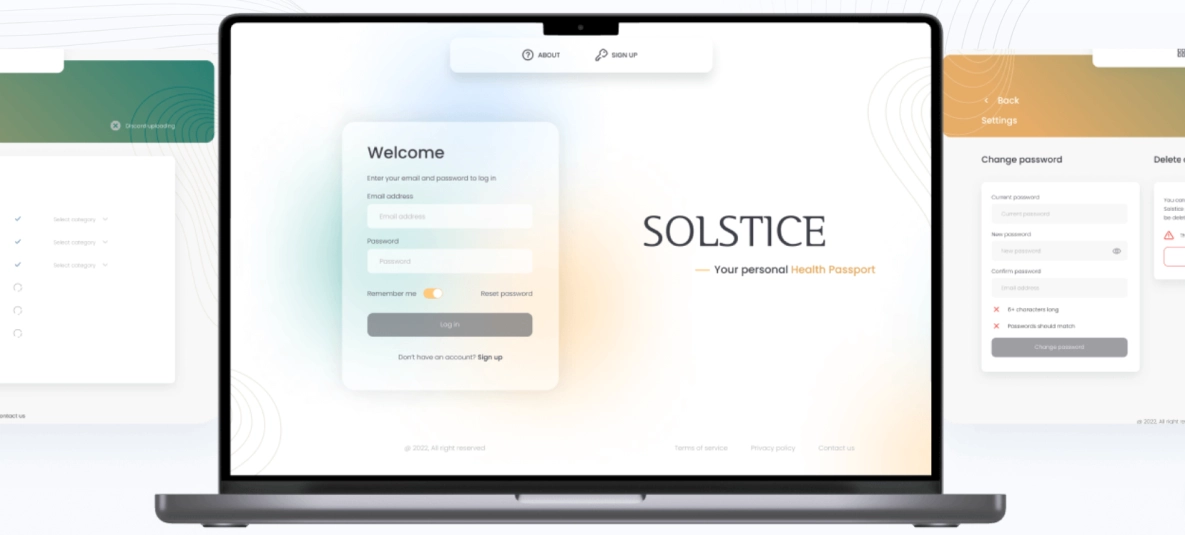
Solstice is a service developed especially for therapeutic organizations (pharmaceutical companies, biotechs, etc.) to easily collect patient data, like genome analyses, X-ray pictures, health records, and more, for better care quality.
To ensure the safety of users’ medical records, we use data encryption that converts data from a readable format into an encoded format. Now the service gives patients ownership over their health data and helps therapeutic companies accelerate their innovation through comprehensive, longitudinal health information.
If you are looking for a trusted healthcare provider, Interexy offers a team of niche-down engineers and designers to work on your project and allow you to get HIPAA-compliant EHR/EMR software. If you’re thinking of storming the healthcare industry with an innovative healthcare app idea, contact us for a detailed estimate. Our fully-packed healthcare mobile app development company in the USA is ready to cover all your needs and ideas!
Final Thoughts
This guide is the way to go if you want to know what an electronic medical record is and how to develop EHR. Here we show you the main points regarding the electronic health records software development process. Even though you can choose ready-made solutions, custom development will bring much more benefits. If you still have questions, let’s have a quick free call with our experts!
As a top-notch telemedicine app development company, we offer clients a practice-proven strategy and stress-free tech implementation. Our deep expertise in medical app development services allow health organizations to implement latest technologies and employ smarter ways of working in order to improve patient care, efficiency, create better consumer experiences and drive better outcomes.
FAQs
-
What is an EHR/EMS System?
EHR/EMR is software that collects electronic records of health-related data on an individual that can be created, collected, managed, and consulted by authorized clinicians and staff within the organization.
-
What is the process for EHR/EMS development?
The EHR/EMS development process includes gathering requirements, business analysis, design, development, testing, data migration, HIPAA compliance, and launch.
-
How to create an electronic medical record system?
You have two options – ready-made software or custom development using healthcare development services provided by experienced teams.
-
What influences the cost of EHR/EMR software development?
The final cost of EMR software development depends on a variety of factors, such as the complexity and features of the application, the tech stack used, and third-party integrations. Achieving scalability and regulatory compliance influences the cost as well. Choosing a customized solution with an intuitive UI/UX design suited for your clinic’s needs costs more than opting for an off-the-shelf one. The cost is also affected by the size and location of the development team.
-
How to create EHR software technology-wise?
The most commonly used programming languages and frameworks to build EHR/EMR software are Python, Java, Kotlin, Swift, Node.js, Angular, and jQuery. Developers also use MySQL and PostgreSQL databases, AWS, Cloudflare, Microsoft Azure, Apache, and Nginx.
